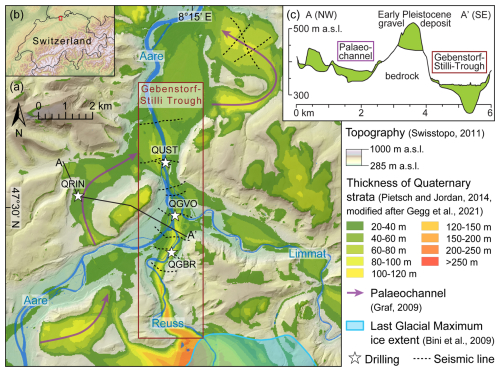The Mid-Pleistocene landscape history of the Lower Aare Valley with emphasis on subglacial overdeepening
Supervisors: Flavio S. Anselmetti and Marius W. Buechi (University of Bern)
Dissertation online: https://doi.org/10.48350/159710
Throughout the Quaternary, extensive valley glaciers repeatedly built up in the European Alps, advanced into the mountain forelands, and at times covered the majority of Switzerland and neighbouring regions with ice (Graf, 2009; Preusser et al., 2011). This had severe geomorphic impacts that include the formation of overdeepenings – closed basins carved by subglacial erosion (Gegg et al., 2025b; Magrani et al., 2020). As major sediment sinks in dynamic settings, where deposits have generally only a low preservation potential, overdeepenings can be invaluable archives of past environments (Anselmetti et al., 2022; Gegg and Preusser, 2023). However, our knowledge of (i) the subglacial conditions and the erosional mechanisms that lead to the formation of overdeepenings and (ii) the regional glaciation history, i.e. the frequency, timing, and extent of ice advances, especially prior to the Late Pleistocene, and the corresponding landscape modifications is still limited. This thesis is centred around four scientific drillings complemented with geophysical data and fieldwork in the Lower Aare Valley in northern Switzerland (Fig. 1), and it addresses the above-mentioned issues.

Figure 1The Lower Aare Valley area (a) in central northern Switzerland (b) with drill sites and seismic lines. Panel (c) shows the occurrence of Quaternary sediments (green) along section A–A′. Quaternary thickness model supplied by the Swiss National Cooperative for the Disposal of Radioactive Waste (Nagra).
Just beyond the extent of the local Last Glacial Maximum, the area hosts the overdeepened Gebenstorf–Stilli Trough, whose subsurface morphology is constrained in a combined active and passive seismic study analysing surface waves and calibrated with existing and new borehole data (Gegg et al., 2021). This approach reveals a complex trough shape composed of two sub-basins separated by a distinct bedrock ridge. The local bedrock architecture consisting of Mesozoic carbonate rocks and Cenozoic molasse deposits is identified as the primary control of the trough shape, and pressurised subglacial water is identified as the main driver of the incision. This is indicated by the highest erosion efficiency in lithologies susceptible to erosion by running water, while little ice-plucked blocks were encountered in the basal trough infill. Further evidence of subglacial water under pressure is presented in a second case study (drilling QGBR; Gegg et al., 2020), where a palaeokarst network in limestone directly underlying the overdeepening is investigated in detail. Here, the karst walls have been intensively fractured by a post-infilling process. Macro- and microscopic evidence suggests that the most plausible scenario explaining the observed structures is small-scale hydrofracturing due to transient peaks in subglacial water pressure.
After incision, the Gebenstorf–Stilli Trough was quickly infilled with sediments whose lithofacies allow the reconstruction of its further evolution (Gegg et al., 2025a). These sediments are, mostly, glaciolacustrine sand and glaciodeltaic gravel that were later truncated and overlain by a second nested glacial basin (with both basin generations likely infilled during the penultimate glaciation, ca. 185–130 ka; see also Mueller et al., 2024). In the gravels, and in Middle Pleistocene glaciofluvial deposits in a neighbouring palaeochannel, petrographic contributions from all three catchments coalescing in the study area (Aare, Reuss, Limmat; Fig. 1) can be identified, and they indicate changes in palaeoglacier configuration and extent over time. In said palaeochannel, another rich archive of environmental indicators occurs in the shape of a succession of lacustrine fines (drilling QRIN; Gegg et al., 2023). Changes in sedimentary facies and composition represent the transition from a glacier- to a runoff-fed lake, and pollen contents track the emergence of sparse aquatic and open terrestrial (interstadial) vegetation. The lacustrine fines, as well as overlying periglacial colluvium, were also dated to the penultimate glaciation by luminescence (OSL/IRSL; Mueller et al., 2020), and thus especially the penultimate glaciation left ample erosive as well as depositional traces in the Lower Aare Valley. The facies and architecture of the investigated deposits points towards three separate, extensive ice advances (cf. Lowick et al., 2015) and therefore towards a complex glacial period with a significant geomorphic imprint. In summary, this study emphasises the significance of glacial (overdeepened) basins and thorough multi-method investigation of their infill for Quaternary stratigraphy.




